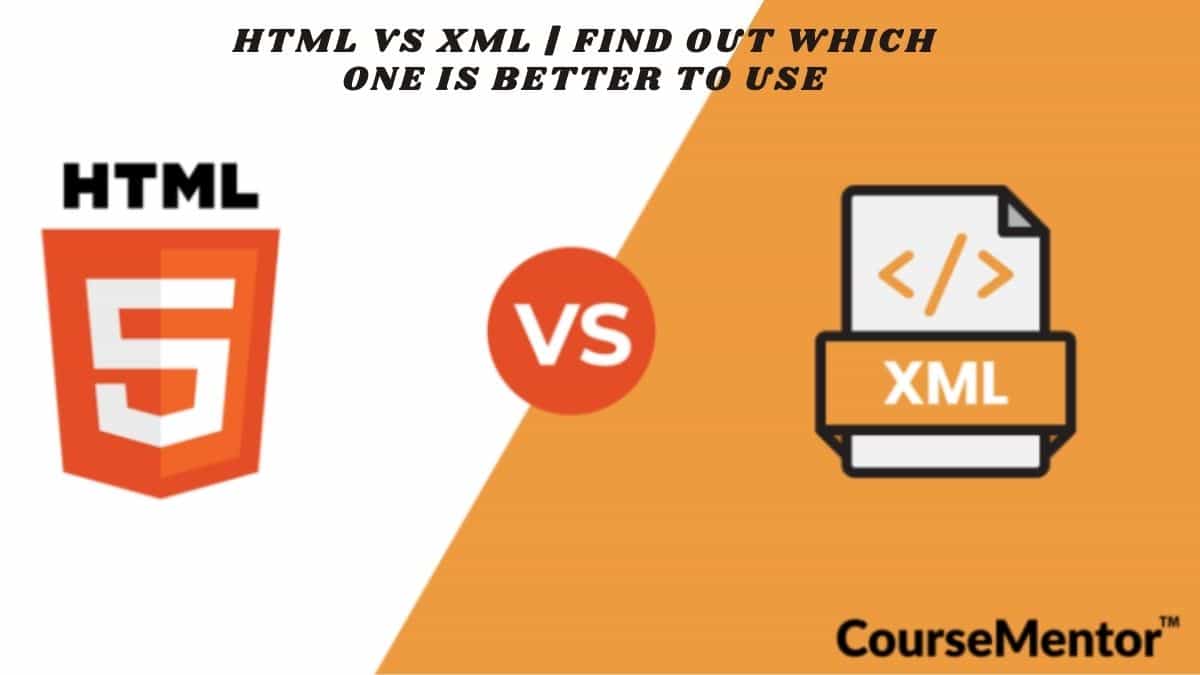Do you know that the pages displayed on the web browsers like Internet Explorer, Safari, Google Chrome, Mozilla Firefox, etc., are coded with the help of HTML and XML? Well, many of you already know that!!
But do you know that both HTML and XML have different features? You might not know that. That is why I am going to explain all the major differences between HTML vs XML.
For a quick start, let me tell you that both are the programming languages used to create several web pages. They both have different features and styles.
Now, before moving to the differences, let’s check some important details about both HTML and XML.
Overview: What is a markup language?
A markup language is a computer language that uses various tags to define elements within a document. It contains simple words rather than typical programming syntax.
There are lots of markup language that people uses around the world, for example:
- HTML: Hypertext text markup language.
- XML: Extensible markup language.
- SGML: Standard generalized markup language.
- XHTML: eXtended hypertext markup language.
- KML: keyhole markup language.
- MathML: Mathematical markup language
But HTML and XML are the most popular languages to design web pages as they are understandable by humans, making it easy to design web pages. Below is the popularity graph of both (HTML vs XML).
What is HTML?
The full form of HTML is HyperText Markup Language. TIM_BERNERS LEE invented HTML later in the 1980s. HTML is the primary and the most commonly used language worldwide to design web pages and websites.
When you start designing web pages, probably HTML is the first language to interact with. HTML defines the way that text, images, and videos are displayed in web browsers.
HTML is used to create or design web pages, or the purpose of HTML to display data and focus on how it looks. It describes the structure of a web page and consists of a series of elements, and these elements tell the browsers how to display the content.
HTML basic program:
Output:
What is XML?
The full form of XML is an Extensible markup language. The language was developed by W3C, which stands for World Wide Web Consortium. XML markup language, much like HTML. This was designed to store, transport data, and also for self-descriptive.
It facilitates encoding documents, defined by some set of rules in a format that humans and machines can read. XML enables the creation of web pages and web applications and is a dynamic language that transports data.
XML plays a vital role in many different IT systems. It is important to have a good basic understanding of XML for the types of software developers. XML is used for distributing data over the Internet.
It is also used for representing arbitrary data structures over the Internet. XML also makes it easier to upgrade or expand to a new operating system, new application, or new browsers without losing data.
XML basic program:
XML tree:
Is XML a Programming Language?
Programming language consists of some grammar rules, and it has its own vocabulary, which we generally use to create various computer programs and applications.
All These programs instruct the system to perform specific tasks. XML does not qualify to be a programming language because it doesn’t perform any computation or algorithms.
XML is generally stored in a simple text file and processed by using some special software capable of interpreting XML. Therefore, XML is not considered to be a programming language.
Now, let’s check the difference between HTML vs XML.
HTML vs XML: What are the major differences among both?
| HTML | XML |
| HTML is a Hypertext markup language. | XML is an extensible markup language. |
| It displays data that describe the structure of a web page. | It basically stores and transfers data and focuses on what data is. |
| The HTML is not case sensitive. | XML is case-sensitive. |
| The HTML is static in nature. | XML is dynamic in nature. |
| HTML has its own predefined tags. | XML is flexible as tags are defined when they are needed. |
| HTML is a markup language. | XML is a standard markup language that defines other markup languages. |
| It offers native support. | With the help of elements and attributes, objects are defined. |
| Extra application code is not required to parse text. | XML DOM application and implementation code are needed to map text back into javascript objects. |
| HTML is used to display data. | XML is used to transfer data. |
| It can be directly viewed on web pages. | Viewable if the proper stylesheet is provided. |
| HTML for humans (Describe web pages). | XML for computers( Describe the data). |
| Content oriented. | Presentation oriented. |
| Browsers are very tolerant of errors in HTML. | Documents in XML must be well-formed (syntactically correct). |
| HTML does not preserve white spaces. | White spaces can be preserved in XML. |
What are the companies that use HTML and XML?
Well, there are numerous companies that are using HTML and XML. Some of the major companies that are using these are:
Which is better: HTML or XML?
Well, for certain purposes, XML is better than HTML. XML offers namespaces support; on the other hand, HTML does not offer any namespace support.
Also, XML is quite strict to the close tags, whereas HTML does not. Moreover, HTML has some limited and predefined tags.
Is XML replacement of HTML?
No, it does not. XML does not replace HTML. Rather than this, it is an alternative option for HTML. It enables the user to define the set of markup elements.
Therefore, HTML is expected to have remained in common use in the upcoming years also.
Conclusion
HTML and XML both are related to each other. On one side, HTML displays data and describes a web page structure, whereas XML stores and transfers data. HTML is a simple predefined language, while XML is a standard language that defines other languages.
I hope you like the blog on HTML vs XML. If you still have any issues regarding both, comment in the below section, and I will provide the best solution to you.
Frequently Asked Questions
What is the purpose of XML?
Extensible Markup Language (XML) uses for describing data. The XML standards are the flexible approach to design information formats and share structured data electronically through the corporate networks and public Internet.
What are the similarities between HTML and XML?
HTML and XML are derived from Standard Generalized Markup Language that is SGML. Both of them use different tags to represent the content within themselves. The data is parsed and read by browsers and software.





